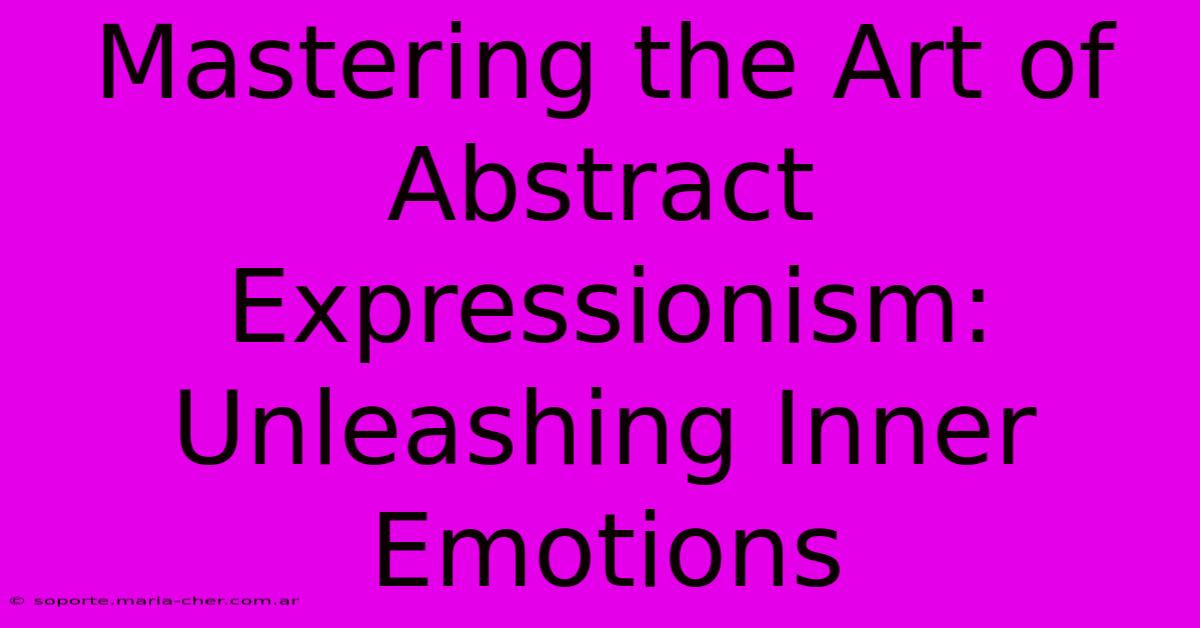Mastering The Art Of Abstract Expressionism: Unleashing Inner Emotions

Table of Contents
Mastering the Art of Abstract Expressionism: Unleashing Inner Emotions
Abstract Expressionism. The very name conjures images of vibrant canvases, bold gestures, and raw emotion laid bare. It's a movement that transcended mere representation, prioritizing the process of creation and the artist's inner world as the primary subject. But how can you master this powerful and evocative style? This comprehensive guide explores the techniques, philosophies, and emotional landscape that define Abstract Expressionism, helping you unlock your own expressive potential.
Understanding the Foundations of Abstract Expressionism
Before diving into the techniques, it's crucial to grasp the philosophical underpinnings of the movement. Abstract Expressionism, born in post-war America, rejected the rigid structures and representational constraints of earlier artistic styles. Instead, it championed:
-
Emotional Intensity: The canvas became a vessel for raw emotion, a space where feelings could be explored and expressed without the limitations of recognizable imagery. Think of the explosive energy in Jackson Pollock's drip paintings or the profound sense of solitude in Mark Rothko's color field works.
-
Spontaneity and Process: The act of creation itself was paramount. Artists embraced improvisation, allowing the process to guide the final outcome. The visible marks and textures on the canvas often tell a story of their own, reflecting the artist's journey.
-
Gestural Abstraction: Many Abstract Expressionist artists used sweeping brushstrokes, energetic drips, and bold lines to convey movement and emotion. These "gestures" become visual equivalents of feeling.
-
Color Field Painting: In contrast to gestural abstraction, color field painting emphasizes large areas of flat color, creating a sense of depth and tranquility. The interplay of color becomes the primary focus.
Essential Techniques for Abstract Expressionism
Now, let's explore the practical techniques that can help you harness the power of Abstract Expressionism:
1. Embracing the Unexpected: Improvisation and Experimentation
Don't be afraid to let go of control. Begin with a loose plan, perhaps a color palette or a general feeling you want to evoke, but allow the process to lead you. Experiment with different tools – brushes, palette knives, even your fingers – to create unique textures and effects.
2. Mastering the Gesture: Brushstrokes and Movement
Practice various brushstrokes. Experiment with speed and pressure to create different textures and marks. Think about the emotional impact of each stroke – a rapid, jagged line might convey anxiety, while a slow, sweeping arc might suggest calmness.
3. Harnessing the Power of Color: Palette and Composition
Color is crucial in Abstract Expressionism. Understand color theory and how colors interact. Explore contrasting colors for dramatic effect, or harmonious colors for a sense of unity. Don't be afraid to experiment with bold, unexpected color combinations.
4. Layering and Texture: Building Depth and Complexity
Layering different colors and textures adds depth and complexity to your work. Try applying thin washes of color over thicker impasto layers, or scraping back layers to reveal underlying colors.
5. Finding Your Voice: Developing Your Personal Style
The key to mastering Abstract Expressionism is to find your unique voice. Don't try to imitate other artists. Instead, focus on expressing your own emotions and experiences through your art. Experiment, explore, and discover what works best for you.
Connecting Emotion to the Canvas: A Practical Exercise
To truly master Abstract Expressionism, you need to connect with your emotions. Try this exercise:
-
Choose an Emotion: Select a strong emotion you want to express – joy, anger, sadness, fear, etc.
-
Choose Your Medium: Select your preferred materials (paints, inks, charcoal, etc.).
-
Let the Emotion Guide You: Allow the chosen emotion to dictate your movements and color choices. Don't overthink it; let the feeling flow onto the canvas.
-
Embrace the Imperfect: Abstract Expressionism is not about perfection. Embrace the mistakes and happy accidents. These often add to the raw energy and emotion of the piece.
Beyond the Canvas: Sharing Your Abstract Expressionist Work
Once you've created your masterpiece, consider sharing your work. Entering art competitions, showcasing your art in local galleries, or even creating an online presence can help you connect with other artists and potential buyers. Online platforms provide a fantastic opportunity to gain exposure, build a community, and even sell your work.
Mastering Abstract Expressionism is a journey, not a destination. It's about embracing the process, exploring your emotions, and developing your unique artistic voice. So grab your brushes, unleash your inner emotions, and begin your creative exploration today.

Thank you for visiting our website wich cover about Mastering The Art Of Abstract Expressionism: Unleashing Inner Emotions. We hope the information provided has been useful to you. Feel free to contact us if you have any questions or need further assistance. See you next time and dont miss to bookmark.
Featured Posts
-
Floral Tape Revolution The Ultimate Guide To Stunning Arrangements
Feb 08, 2025
-
Azures Heavenly Hues Unveiling The Magic Of Blue Roses
Feb 08, 2025
-
Capture Your True Essence The Ultimate Guide To Posing And Lighting For Stunning Self Portraits
Feb 08, 2025
-
The Ultimate Guide To Portrait Types Enhance Your Storytelling Skills
Feb 08, 2025
-
Unlock The Mystery Polaroid Picture Sizes Explained For All Photographers
Feb 08, 2025
